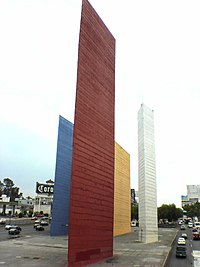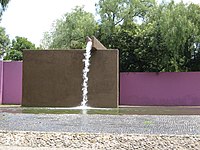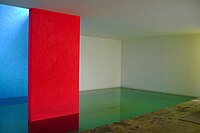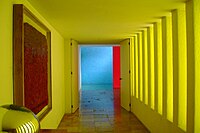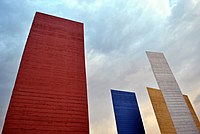Luis Barragán Morfín
Luis Ramiro Barragán Morfín (born March 9, 1902 in Guadalajara , † November 22, 1988 in Mexico City ), mostly known as Luis Barragán, was a Mexican architect whose life work was awarded the Pritzker Prize for Architecture in 1980 , one of the world's most renowned Architecture prizes, was recognized.
Life
Luis Barragán was born the third of nine children on the Hacienda des Corrales in Guadalajara. His parents were wealthy landowners who were expropriated in 1935 under Lázaro Cárdenas . He was educated in Catholic schools and was a devout Catholic all his life. He studied from 1919 to 1923 at the de Escuela Libre Ingenieros in Guadalajara Engineering . 1925–1927 he went on an extensive study trip through Europe. He was particularly interested in the Moorish architecture in southern Spain, Mediterranean European architecture, the gardens of the painter Ferdinand Bac and the theoretical writings of Le Corbusier . He attended the International Exhibition of Arts Decoratifs, which took place in Paris in 1925. In 1931 he traveled to Europe for a second time via Chicago and New York, where he met Frederick Kiesler . Here he became acquainted with Le Corbusier and Ferdinand Bac.
His early designs were shaped by experiences in Europe and North America and quickly approached the international style . But he also took up Japanese influences. In 1935 Barragán moved from Guadalajara to Mexico City and from the 1940s he devoted himself to the opening up and development of metropolitan residential areas, such as the Jardines del Pedregal settlement in the south of Mexico City. Here he bought 323 hectares of a lava field from the Xitle volcano in 1944 and built a new housing estate . Barragán worked with the Mexican painter Jesú Reyes Fereira , who was particularly interested in traditional Mexican architecture. The gardens with swimming pools and lawns were integrated directly into the lava flows, and the rock only had steps. The smooth walls of the houses were painted in bold colors at the suggestion of Reyes Fereira, which later became Barragán's trademark. The houses had large courtyards and picture windows. When planting, he preferred to use native plants such as pine, mimosa, jacaranda and the cactus Senecio praecox . The walls of the houses were overgrown with climbing plants. Armando Salas Portugal's photographs made the modernist facility famous around the world. In 1958 Barragán bought land in the future suburb of Arboledas . He designed houses and gardens, which he successfully sold after construction. There were grounds in which the wealthy owner could also keep horses, with stables, horse ponds , drinking troughs , riding trails and pastures. He then developed Les Clubes (1961–1972). This is where the Folke Egeström House became best known. The swimming pool was fed by broad, shallow water channels at a higher elevation, another trademark of Barragán. The house was white, the rectangular walls of the extensive stables were in dark red, orange, magenta and light red.
A number of residential buildings and complexes that are characterized by a minimalist design language and the expressive use of color made him known beyond the professional world . Barragán thus combined modern architecture with a regional artistic tradition.
Barragán was always looking for an exchange with other intellectuals and artists and has worked closely with photographers since the beginning of his professional activity. As the most important partner, the Mexican photographer Armando Salas Portugal accompanied and documented the work of Luis Barragán in a congenial way for decades. Together with the artist Mathias Goeritz , who emigrated from Germany , Barragán created the Torres Satélite (1957–58), a large-scale urban sculpture in the middle of a main artery of Mexico City.
meaning
Barragán had a great influence on the modern architectural tradition of Mexico, but also on contemporary garden design. He is considered a "master of emotional architecture". His gardens are shaped by his attention to the relationship between house and landscape. The main influences are Islamic gardens, especially the Moorish gardens of Spain and the international style in architecture, especially the work of Le Courbusier. In most of his gardens, water is a defining design element (rectangular ponds, straight channels that take up the motif of the Islamic Tschāhār Bāgh and waterfalls), in addition there are the characteristic rectangular partial walls, which are plastered in strong primary colors (mostly red, blue and white) and master the design. The range of plants is characterized by Mediterranean species, but Barragán also used Australian species such as eucalyptus and numerous plants from the arid regions of the Neotropics .
Barragan's walls have been resumed by modern day gardeners such as Christopher Bradley-Hole .
Awards
- 1980 Pritzker Prize for Architecture ("Nobel Prize" for Architecture)
- 1984 honorary member of the American Academy of Arts and Letters
- 1987 American Prize for Architecture
- 2004 Casa Barragán is included in the UNESCO World Heritage List
The 1996 Barragan Foundation, which manages his estate, is based in Birsfelden .
Buildings (selection)
- 1947–48 Casa Barragán owns home in Tacubaya , Mexico City, UNESCO World Heritage Site
- 1953–60 Convent and chapel of the Capuchinas Sacramentarias del Purisimo Corazón de Maria in Tlalpan , Mexico City with Mathias Goeritz
- 1955 Casa Antonio Gálvez in San Angel, Mexico City
- 1958–63 Subdivisión Las Arboledas in Atizapán de Zaragoza , Mexico City
- 1961–72 Los Clubes and Casa Egerström in Atizapán de Zaragoza, Mexico City
- 1975–77 Casa Gilardi , Mexico City
Gardens
- Plaza del Bebedreo de los Caballos, Los Arboledas (Mexico), 1961.
- "Campbell Divertimento" fountain in Beverly Hills, Los Angeles , erected posthumously
Exhibitions
- "Luis Barragán. The silent revolution". Vitra Design Museum , Weil am Rhein 2000.
gallery
Literature (selection)
- Jose M. Buendia Julbez, Juan Palomar and Guillermo Eguiarte: The Life and Work of Luis Barragan 1902–1988. Rizzoli, New York 1997, ISBN 978-0-8478-2057-3 .
- René Burri : Luis Barragán , Phaidon, London 2000, ISBN 0-7148-9082-0 .
- Keith L. Eggener: Luis Barragan's Gardens of El Pedregal. Princeton Architectural Press, New York 2011, ISBN 978-1-56898-267-0 .
- Adolf K. Placzek : Macmillan Encyclopedia of Architects. Vol. 1. The Free Press, London 1982, ISBN 0-02-925000-5 .
- Danièle Pauly: Barragán, space and shadow, wall and color. Birkhäuser, Basel a. a. 2002, ISBN 3-7643-6678-8 .
- Raul Rispa (Ed.): Barragán - The Complete Works. Princeton Architectural Press, New York 2003, ISBN 1-56898-322-0 .
- Dennis Sharp : The Illustrated Encyclopedia of Architects and Architecture. Quatro Publishing, New York 1991, ISBN 0-8230-2539-X .
- Wim van den Bergh and Kim Zwarts: Luis Barragán: The Eye Embodied. Pale Pink Publishers, Maastricht 2006, ISBN 90-810089-1-9 .
- Federica Zanco (ed.): Luis Barragán - The silent revolution. Skira, Geneva 2001, ISBN 88-8118-779-5 (also published in English, Spanish and Japanese).
Documentary film
- Guido de Bruyn: Luis Barragan - The Quiet Revolution , film documentation.
Web links
- Barragan Foundation - The Archives of Luis Barragán 2. Click on the black page above.
- Entry by Luis Barragán Pritzker Architecture Prize Laureate
- Entry by Luis Barragán on greatbuildings.com
- Entry by Luis Barragán on Unesco World Heritage Center
- The Casa Barragan (span.)
- Luis Barragán Morfín. In: arch INFORM .
- Literature by and about Luis Barragán Morfín in the catalog of the Ibero-American Institute of Prussian Cultural Heritage, Berlin
- Archmaps | Architecture Guide Map of Great Architects | Luis Barragan
- bibliography
Individual evidence
- ↑ Janet Waymark 2003, Modern garden design, innovation since 1900. London, Thames and Hudson, 143.
- ↑ Janet Waymark 2003, Modern garden design, innovation since 1900. London, Thames and Hudson, 147.
- ↑ Janet Waymark 2003, Modern garden design, innovation since 1900. London, Thames and Hudson, 144.
- ↑ Janet Waymark 2003, Modern garden design, innovation since 1900. London, Thames and Hudson, 147.
- ↑ Janet Waymark 2003, Modern garden design, innovation since 1900. London, Thames and Hudson, 148.
- ↑ Guy Cooper, Gordon Taylor 1996. Paradise transformed. The private garden for the 21st century. New York, Monacelli Press, Nov.
- ↑ Jose M. Buendia Julbez, Juan Palomar, Guillermo Eguiarte, The Life and Work of Luis Barragan 1902-1988. Rizzoli 1997
- ↑ Honorary Members: Luis Barragán. American Academy of Arts and Letters, accessed March 5, 2019 .
- ↑ Guy Cooper, Gordon Taylor 1996. Paradise transformed. The private garden for the 21st century. New York, Monacelli Press, Dec.
- ↑ Lilian Pfaff, discovered late work by Luis Barragan. Tec 21 136, No. 16/17, 2010, p. 27. ISSN 1424-800X
- ↑ Longingly closer. "Luis Barragan. The Quiet Revolution". Vitra Design Museum, Weil am Rhein. Deutsche Bauzeitschrift 48/9, 2000, p. 18. ISSN 0011-4782
| personal data | |
|---|---|
| SURNAME | Barragán Morfín, Luis |
| ALTERNATIVE NAMES | Barragán Morfín, Luis Ramiro |
| BRIEF DESCRIPTION | mexican architect |
| DATE OF BIRTH | March 9, 1902 |
| PLACE OF BIRTH | Guadalajara , Mexico |
| DATE OF DEATH | November 22, 1988 |
| Place of death | Mexico city |

